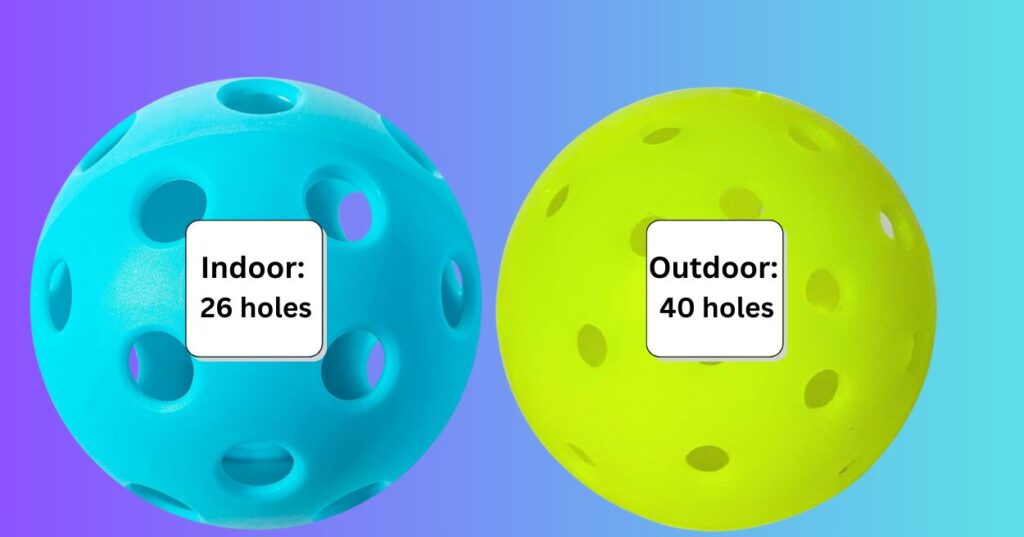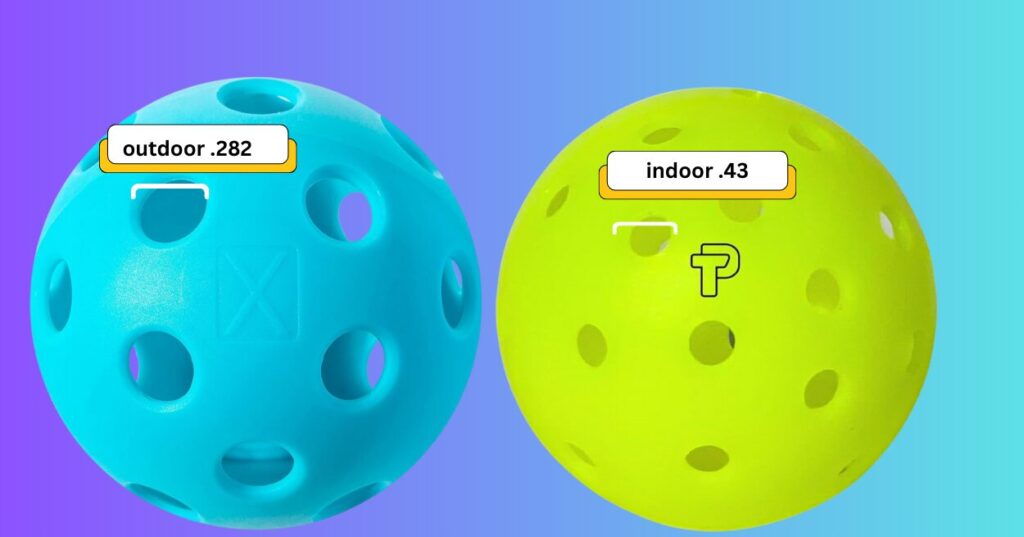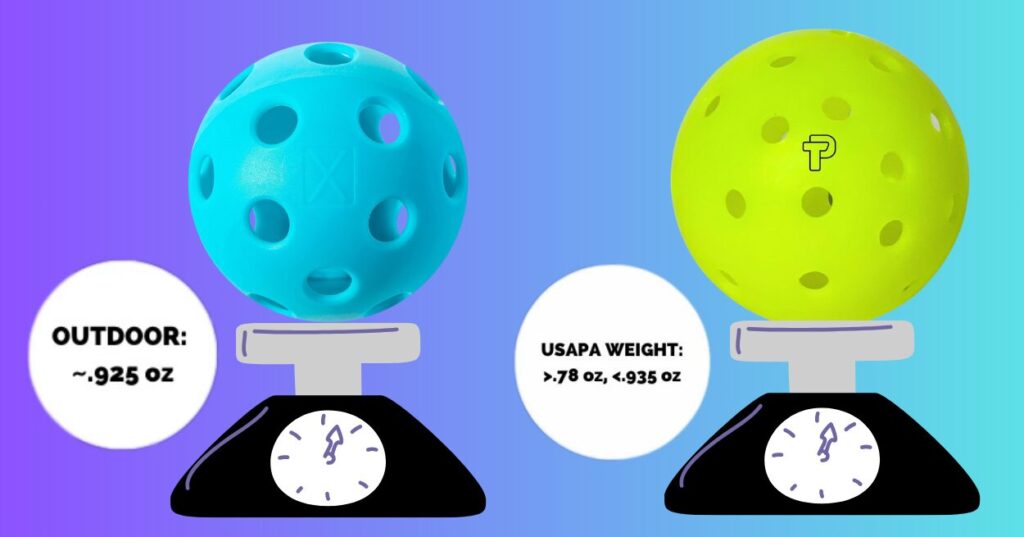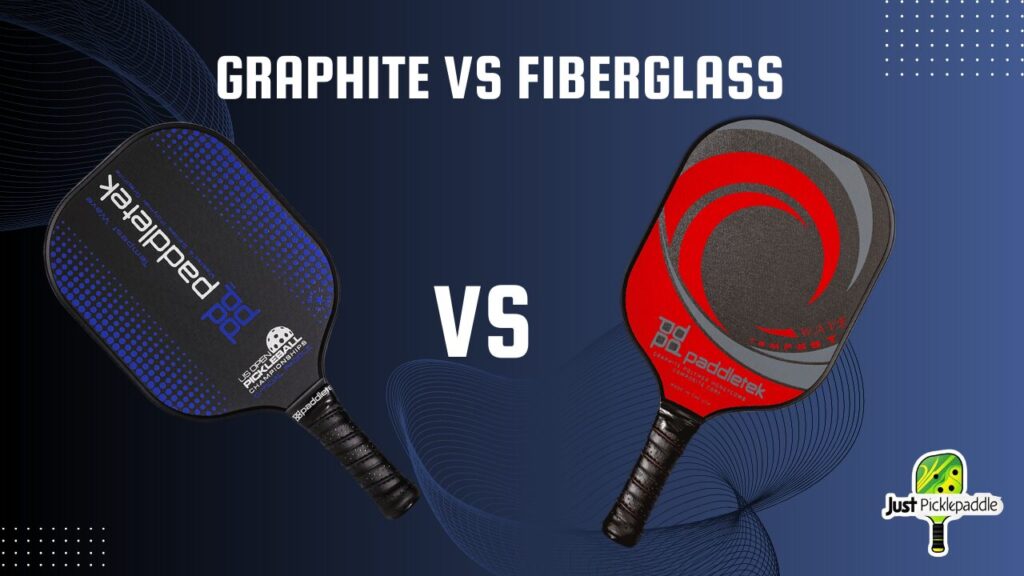Have you ever wondered why your pickleball game feels different when switching between indoor and outdoor courts? The answer lies in the type of ball you’re using. Indoor vs outdoor pickleballs are designed with distinct features to optimize performance in their respective environments. Indoor balls typically have larger holes and are softer, providing better control on smooth surfaces. In contrast, outdoor balls are heavier with smaller holes, making them more durable and stable in windy conditions.
Understanding these differences is crucial for selecting the right equipment and enhancing gameplay. In this blog, we’ll delve into the key distinctions between indoor and outdoor pickleballs and how choosing the appropriate one can significantly impact your game.
Table of Contents
Understanding Pickleball Balls
Pickleball balls are designed with specific features to enhance gameplay in various environments. Indoor balls typically have 26 larger holes and are made from softer plastic, which makes them lighter and easier to control on smooth surfaces like gym floors. In contrast, outdoor balls are constructed with 40 smaller holes and more rigid plastic, providing improved durability and stability to withstand wind and rough outdoor court conditions.
Choosing the right ball is essential for optimal performance. Indoor balls provide a quieter and more controlled game, making them ideal for indoor settings, whereas outdoor balls are built to withstand the challenges of wind and various surfaces. Selecting the appropriate ball based on your playing environment can greatly impact your game experience and performance.
Indoor Pickleball Balls: Designed for Controlled Play
Indoor pickleball balls are specifically engineered for controlled environments such as gym courts, schools, churches, and community centers. These balls are designed to offer a slower pace and improved control, making them ideal for strategic play on smooth surfaces.
Key Features:
- Number of Holes: Typically offers 26 larger holes, promoting slower play and enhanced control.
- Material and Weight: Made from softer plastic, these balls are lighter and less affected by wind, ensuring consistent performance indoors.
- Bounce Characteristics: Designed for lower bounce, facilitating longer rallies and a more controlled game.
- Color Options: Available in dark green, blue, and red to improve visibility on light-colored indoor courts.
By understanding these features, players can choose the right ball for their playing environment, ensuring an optimal and enjoyable game.
Outdoor Pickleball Balls: Built for the Elements
Outdoor pickleball balls are engineered to endure the challenges of outdoor play, including wind and rougher surfaces. With 40 smaller holes, these balls are heavier and more durable, ensuring consistent performance in dynamic conditions.
Key Features:
- Number of Holes: Equipped with 40 smaller holes, allowing for a faster and more stable flight path, even in windy conditions.
- Material and Weight: Made from tougher plastic, these balls are heavier, offering enhanced durability and resistance to cracking.
- Bounce Characteristics: Designed to have a higher bounce, facilitating a faster-paced game suitable for outdoor surfaces.
- Color Options: Available in bright colors like neon green and yellow to enhance visibility under natural light.
Understanding these features will help you choose the right ball for your outdoor pickleball games, ensuring optimal performance and enjoyment.
How Do You Tell The Difference Between Indoor vs Outdoor Pickleballs?
To the trained eye, the differences between indoor and outdoor pickleballs may not be immediately apparent when held side by side. Although they appear similar, some glaring distinctions become obvious once you focus on a few key details. Most of the differences lie in the number of holes. Indoor balls typically feature 26 holes, whereas outdoor balls have 40 holes, with the latter possessing wider diameters for better stability in windy conditions.
Weight is another factor that distinguishes the two; outdoor balls are generally heavier due to their thicker, more rigid plastic, making them better suited to handle the elements. In contrast, indoor balls are made from softer materials and bounce lower, facilitating longer rallies on smooth indoor surfaces.
Durability also varies: Outdoor pickleball balls are more durable but crack faster than their softer indoor counterparts. Different brands and types of balls may adhere to the specifications set by governing bodies like USA Pickleball, and these unique metrics ensure that the balls are approved for official play.
How Holes Affect the Performance of Pickleballs
The number of holes in pickleballs plays a vital role in determining the consistency of the ball’s flight trajectory and its performance during various shots. Outdoor balls typically have 40 holes, more closely packed than indoor varieties with 26 holes.

This difference in the number of holes affects the ball’s aerodynamics, allowing outdoor pickleball to withstand wind and other external factors better and ensure it stays true to its path in windy conditions. The wider holes on indoor balls provide more control on smooth indoor surfaces, resulting in a slower, more predictable bounce.
The smaller holes in outdoor balls are designed for durability, allowing them to withstand harsher elements. The beveled plastic surrounding the holes ensures consistent size and placement, enhancing the ball’s overall stability. While there are exceptions in the market where outdoor pickleballs come in two sizes, the same ball generally follows these standard hole specifications for optimal performance across various court types.
How Hole Diameter Affects Pickleball Performance
The diameter of the holes in a pickleball significantly influences its flight characteristics, speed, and control. Indoor and outdoor pickleballs are designed with different hole sizes to optimize performance in their respective environments.

Indoor Pickleball Balls:
- Hole Diameter: Approximately 0.43 inches.
- Flight Characteristics: Larger holes result in higher drag, leading to a slower flight and higher bounce.
- Control: The increased drag allows for more controlled shots, making them ideal for indoor play where precision is crucial.
- Wind Resistance: The larger holes make indoor balls less suitable for outdoor play, as wind affects them more.
Outdoor Pickleball Balls:
- Hole Diameter: Approximately 0.282 inches.
- Flight Characteristics: Smaller holes reduce drag, allowing for a faster flight and lower bounce.
- Control: While they offer less control than indoor balls, their design is optimized for outdoor play, where speed is advantageous.
- Wind Resistance: The smaller holes enhance stability in windy conditions, making them suitable for outdoor play.
Understanding the impact of hole diameter on pickleball performance can help players select the appropriate ball for their playing environment, ensuring optimal gameplay.
How Weight Affects Outdoor and Indoor Pickleballs
The weight of pickleball is another critical factor differentiating the indoor and outdoor versions. Outdoor pickleballs are generally heavier than their indoor counterparts, mainly due to the number of holes and the materials used. Indoor pickleball typically has 26 holes, while outdoor pickleball features 40 holes, each with a larger diameter. This design results in a 40% greater surface area, creating more negative space and contributing to the lighter weight of the indoor ball.
A heavier ball used for outdoor play is beneficial because it is less affected by wind interference and can more effectively maintain its intended course. In contrast, the lighter weight of indoor balls makes them easier to control on smooth indoor surfaces. This weight variation is a logical approach to ensuring that the ball performs optimally under the external conditions of the court, whether indoors or outdoors.
Weight Differences Between Indoor and Outdoor Pickleballs
The weight discrepancy between indoor and outdoor pickleballs is minimal, typically under 1%. Indoor balls average around 0.917 ounces, whereas outdoor balls are slightly heavier at approximately 0.925 ounces.

Key Points:
- Minimal Weight Variation: The difference in weight is negligible and does not significantly impact gameplay.
- Regulatory Standards: According to the USA Pickleball Equipment Standards Manual, pickleballs must weigh between 0.78 and 0.935 ounces to be approved for play.
- Material and Design Factors: The slight weight difference between indoor and outdoor balls is influenced by variations in hole size, material hardness, and construction methods.
Understanding these nuances can help players choose the appropriate ball for their playing environment, ensuring optimal performance.
The hardness of a pickleball, determined by the type of plastic used in its construction, plays a significant role in its performance on the court. Hardness is typically measured using the Shore D durometer scale, where higher values indicate harder materials. This measurement influences various aspects of the ball’s behavior, including bounce, durability, and speed.
Material Hardness:
- LDPE (Low-Density Polyethylene): 40–50 Shore D
- HDPE (High-Density Polyethylene): 60–70 Shore D
- PP (Polypropylene): 70–83 Shore D
- PET (Polyethylene Terephthalate): 85–95 Shore D
Indoor vs. Outdoor Balls:
- Indoor Balls: Typically made from softer plastics like LDPE or TPE, resulting in a lower Shore D hardness. This softness provides a controlled, slower bounce suitable for indoor courts.
- Outdoor Balls: Constructed from more rigid plastics such as HDPE or PET, offering higher Shore D hardness. This increased hardness enhances durability and performance in outdoor conditions, where wind and rough surfaces are factors.
Understanding the hardness of a pickleball helps players select the appropriate ball for their playing environment, ensuring optimal performance and enjoyment of the game.
Which is Harder – Indoor or Outdoor Pickleballs?
Due to their materials and construction thickness, outdoor pickleball courts are generally more complex than indoor ones. Indoor pickleball courts are made from softer plastic, which allows for a slower pace and greater control on smooth indoor court surfaces.
Outdoor pickleballs are made from heavier, thicker plastic, which makes them more durable and resilient. They are designed to withstand harsh weather conditions and rough surfaces. The strong construction of outdoor balls ensures they retain their shape and performance even during windy and outdoor play.
How Durability Affects Indoor and Outdoor Pickleballs
Durability is a crucial factor for both beginners and experienced pickleball players. Outdoor pickleballs are made from harder materials and are designed to withstand harsher conditions, such as temperature fluctuations and rough surfaces. However, this more rigid material generally has a shorter lifespan than indoor pickleballs. The outdoor balls are more likely to crack due to the effects of external conditions, like wind or contact with rough surfaces.
On the other hand, indoor pickleballs are typically made from materials like TPE (thermoplastic elastomer), which have elastic properties that make them resistant to cracking or changing shape. While indoor balls may not be as durable in outdoor conditions, their softer construction ensures a longer lifespan on smooth indoor court surfaces, providing consistent play over time without easily losing their shape.
Durability Comparison: Indoor vs. Outdoor Pickleballs
The durability of pickleballs varies significantly between indoor and outdoor designs, primarily due to differences in material hardness and construction.
Indoor Pickleballs:
- Material: Crafted from softer plastics like LDPE or TPE, making them more susceptible to wear and tear on rough surfaces.
- Design: Larger holes and lighter weight reduce durability when exposed to outdoor elements.
- Lifespan: Typically lasts longer on smooth indoor courts but degrades quickly if used outdoors.
Outdoor Pickleballs:
- Material: Manufactured from more rigid plastics such as HDPE or PET, enhancing resistance to cracking and deformation.
- Design: Smaller holes and heavier weight provide stability in windy conditions and durability on rough surfaces.
- Lifespan: While more durable outdoors, they are prone to wear over time and may crack after extensive use.
In summary, while outdoor pickleballs are engineered for more outstanding durability against environmental factors, both types have a finite lifespan and should be replaced when signs of wear appear.
Using Indoor Pickleballs Outdoors and Outdoor Pickleballs Indoors
While you can technically play indoor and outdoor pickleball, it’s not recommended for optimal play. Indoor pickleballs are lighter and designed to perform predictably on smooth, indoor court surfaces. However, wind can easily affect it when played outdoors, causing it to move too slowly and disrupting the game’s pace.
Additionally, the lighter plastic used in indoor balls makes them less durable and more susceptible to damage in outdoor conditions, especially when exposed to the sun or the intense heat of a Florida summer afternoon.
On the other hand, outdoor pickleball is designed for durability and is made from heavier plastic that can withstand the elements. However, it may feel too hard and bouncy when used indoors. Outdoor balls are often overlooked in indoor settings, as they are intended for rougher conditions and might not provide the same level of control as indoor balls.
While it’s possible to flip the script, using the appropriate ball implementation is essential to achieve the best playing experience.
How important is it to pick the Right Ball for Your Playing Environment
Choosing the right pickleball for your game depends on the playing conditions. Selecting the appropriate ball indoors or outdoors will ensure the best experience. Outdoor pickleball is designed to withstand rough surfaces and elements like wind, featuring 40 holes to enhance its performance. These balls tend to be heavier and more complex, making a more durable game suitable for outdoor play.
On the other hand, indoor balls are generally lighter and have fewer holes, making them better suited for a slower game on smooth, controlled surfaces. They offer more control, which is ideal for strategic plays. When selecting the right ball, consider five factors: the number of holes, hole size, weight, hardness, and durability. Each of these affects how the ball behaves in different environments, and understanding them will help prevent frustration during your game.
What Is the Difference in the Design of the Balls for Indoor and Outdoor Pickleball?
Indoor and outdoor pickleballs are designed to withstand the challenges of their respective environments. Outdoor balls are constructed to endure changing weather conditions, such as heat, humidity, and wind. They are made with more rigid plastics and feature larger holes to help maintain stability in outdoor climates. These materials are more durable and handle rough surfaces and outdoor elements.
In contrast, indoor pickleballs are designed for climate-controlled environments, such as gym courts, where temperature and wind are more predictable. These balls are typically lighter, made from softer plastics, and have smaller holes to provide a more controlled game on smooth indoor surfaces. The differences in design reflect the need for each ball to perform optimally in its specific environment.
Outdoor vs Indoor Pickleball: Which Is Better?
Deciding between outdoor and indoor pickleball ultimately comes down to the differences in playing conditions and each environment’s specific challenges. Outdoor balls are larger and heavier, designed to travel further, which makes them better suited for windy conditions. They generally have a slower bounce, providing more power while requiring greater control to maintain consistency during play.
In contrast, indoor balls are smaller, lighter, and move faster, facilitating a quicker pace of play. Their lighter weight makes them ideal for a technical game emphasizing precision and control over raw power. Indoor pickleball may be your best option if you seek a game with more strategy and rapid action. At the same time, outdoor pickleballs are better suited for a dynamic game that prioritizes power and distance. Each ball offers its own set of advantages based on the playing environment.
Final Thought
The choice between indoor and outdoor pickleballs ultimately depends on your playing environment and preferred game style. Outdoor balls are more suitable for windy conditions and rougher surfaces, offering increased power and distance, while indoor balls provide a faster-paced, precision-focused game in climate-controlled settings. Understanding these differences will help you select the ball that best aligns with your needs, ensuring you have the best playing experience in each scenario.
What is the difference between the two pickleball balls?
Outdoor pickleball balls are designed with thicker plastic, smaller holes, and increased weight compared to their indoor counterparts. These features enhance their performance in outdoor conditions. The smaller holes reduce the ball’s sensitivity to wind, while the thicker plastic construction improves durability, allowing the ball to withstand the rigors of outdoor play .
How do I choose pickleballs?
Indoor and outdoor pickleballs differ in design to suit their environments:
Indoor Balls: Feature 26 larger holes, softer plastic, and are lighter, offering slower play and higher bounce on smooth surfaces.
Outdoor Balls: Have 40 smaller holes, harder plastic, and are heavier, providing better durability and wind resistance for faster play on rough surfaces.
Choosing the appropriate ball enhances gameplay by matching the ball’s characteristics to the playing conditions
What ball is used in professional pickleball?
The ONIX Dura Fast 40 pickleball is engineered for high-speed outdoor play, featuring a patented 40-hole design with varying hole sizes to enhance flight stability and minimize wind interference. Its one-piece, seamless construction ensures consistent bounce and durability, making it the official ball of the USA Pickleball Association National Championships . Many professional players favor the Dura Fast 40 for its responsiveness and performance in competitive settings.




I just couldn’t depart your website prior to suggesting that I really enjoyed the standard information a person provide for your visitors? Is going to be back often in order to check up on new posts
Excellent read, I just passed this onto a friend who was doing some research on that. And he actually bought me lunch as I found it for him smile So let me rephrase that: Thanks for lunch!
Thank you for sharing with us, I believe this website truly stands out : D.
It’s really a great and helpful piece of information. I’m happy that you shared this helpful info with us. Please stay us up to date like this. Thank you for sharing.
Pingback: Indoor vs Outdoor Pickleballs: The Ultimate Comparison – Pickleball Paddle